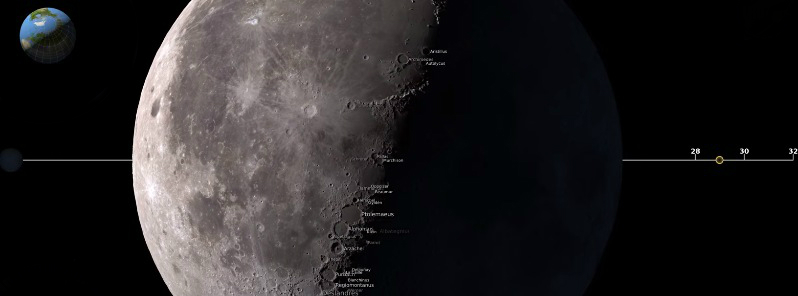Moon’s phases and libration at hourly intervals throughout 2016

These visualizations show the Moon's phases and libration at hourly intervals throughout 2016, as viewed from both northern and southern hemispheres. Each frame represents one hour.
In addition, the visualizations show the Moon's orbit position, sub-Earth and subsolar points, distance from the Earth at true scale, and labels of craters near the terminator.
Northern hemisphere

Southern hemisphere


The Moon always keeps the same face to us, but not exactly the same face. Because of the tilt and shape of its orbit, we see the Moon from slightly different angles over the course of a month. When a month is compressed into 24 seconds, as it is in this animation, our changing view of the Moon makes it look like it's wobbling. This wobble is called libration.
The word comes from the Latin for "balance scale" (as does the name of the zodiac constellation Libra) and refers to the way such a scale tips up and down on alternating sides. The sub-Earth point gives the amount of libration in longitude and latitude. The sub-Earth point is also the apparent center of the Moon's disk and the location on the Moon where the Earth is directly overhead.
The Moon is subject to other motions as well. It appears to roll back and forth around the sub-Earth point. The roll angle is given by the position angle of the axis, which is the angle of the Moon's north pole relative to celestial north. The Moon also approaches and recedes from us, appearing to grow and shrink. The two extremes, called perigee (near) and apogee (far), differ by about 14%.
The most noticed monthly variation in the Moon's appearance is the cycle of phases, caused by the changing angle of the Sun as the Moon orbits the Earth. The cycle begins with the waxing (growing) crescent Moon visible in the west just after sunset. By the first quarter, the Moon is high in the sky at sunset and sets around midnight. The full Moon rises at sunset and is high in the sky at midnight. The third quarter Moon is often surprisingly conspicuous in the daylit western sky long after sunrise.
Caption and video credit: NASA's Scientific Visualization Studio.

Navigate the month, as presented on this site represents what is visible from the Earth in the same complex movements and the moon. The exact path of the Moon around the planet and the planet moves around the center of mass that moves along the ellipse around the sun. And the planets and the moon rotate around the center of mass (CM) making coupling of two spins of the same intensity, and different directions. The CM is a spin rotation celestial body whose radius of movement sinusoidal, and rotates the opposite spin of the heavenly bodies.
The radius is: r = t / T .a. e.sin (fi). 1 / [(1-e ^ 2)] ^ 1/2 t = time spin T = time of revolution a = semi-major axis of the ellipse e = eccentricity of the orbit of the observed body. fi = angle between the directions of the center of rotation and perihelion and center of rotatio-body position.
If someone is interested in this, I own detailed evidence on the cause of the spin of the heavenly bodies.